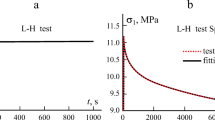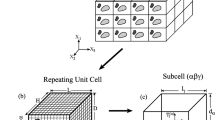Abstract
In experimental fracture studies of viscoelastic polymers presently available optical measurement methods need to be modified to account for the rate sensitivity of the physical properties. Here, photoviscoelastic behavior is examined for the purpose of determining the mechanical state of stress and strain at the tip of a crack moving through a viscoelastic solid. The linearly opto-mechanical constitutive relation is derived from mechanical and dielectric relaxation functions for thermorheologically simple solids via the Clausius-Mosotti-Lorentz-Lorenz (CMLL) relation, which derivation is consistent with the Maxwell-Neumann relation in the limit of elastic behavior; also, approximate functions in place of the CMLL relations are explored.
Computations of the caustic, based on the square root singular stress field at the tip of a steadily propagating crack show that the crack speed has a pronounced effect on the size of the caustic but leaves the shape virtually unchanged. A knowledge of the phenomenological opto-mechanical properties of the polymer allows thus the determination of the stress intensity factor in (linearly) viscoelastic solids, though that determination must be effected through a de-convolution rather than through an algebraic computation as in the case of elastic solids.
Résumé
Dans les études actuellement disponibles sur la rupture des polymères viscoélastiques, les méthodes de mesure optique doivent être adaptées pour tenir compte de la sensibilité des propriétés physiques à la vitesse de sollicitation. Dans le présent travail, on examinera le comportement photo-viscoélastique dans le but de déterminer l'état mécanique des contraintes et des déformations à l'extrémité d'une fissure en progression dans un solide viscoélastique. La relation linéaire constitutive entre propriétés optiques et mécaniques est tirée de fonctions de relaxation mécaniques et diélectrique pour des solides thermoréologiquement simples, via la relation de Clausius-Mosotti-Lorentz-Lorentz (CMLL). Cette approche est cohérente avec la relation de Maxwell-Neumann dans les limites du comportement élastique. On explore également l'usage des fonctions approchées en lieu et place de la relation de CMLL.
Les calculs de la caustique basés sur le champ de contraintes de singularité −1/2 à l'extrémité d'une fissure en propagation stable montrent que la vitesse de propagation a un effet prononcé sur la dimension de la caustique, bien que la forme en soit virtuellement inchangée. Ainsi, une connaissance des propriétés opto-mécaniques d'un polymère permet de déterminer un facteur d'intensité de contraintes dans des solides (linéairement) viscoélastiques, même si cette détermination doit être effectuée via une déconvolution plutôt que via un calcul algébrique, comme c'est le cas dans les solides élastiques.
Similar content being viewed by others
References
J.W.Dally and W.F.Riley, Experimental Stress Analysis, 2nd ed., McGraw-Hill, New York (1978).
R.D.Mindlin, Journal of Applied Physics 10 (1939) 273–294.
A.A. Wells and D. Post, Proceedings of the Society for Experimental Stress Analysis 16 (1958) 69–92, and discussion by G.R. Irwin, 16 (1948) 93–96.
P. Manogg, Ph.D. dissertation, University of Freiburg (1964).
P.S.Theocaris and E.E.Gdoutos, Journal of Applied Mechanics 39 (1972) 91–97.
J. Beinert and J.F. Kalthoff, Chapter in Mechanics of Fracture, VII, George C. Sih (ed.) (1981).
A.J.Rosakis, C.C.Ma, and L.B.Freund, Journal of Applied Mechanics 50 (1983) 777–782.
M.V.Klein, Optics, John Wiley & Sons, New York (1970).
H.A.Lorentz, Annales of Physics 9 (1880) 641.
J.H.Gladstone and T.P.Dale, Transactions of the Royal Society A 148 (1858) 887.
W.M. Beebe, Ph.D. thesis, California Institute of Technology (1966).
C.Kittel, Introduction to Solid State Physics, 4th ed., John Wiley & Sons, New York (1971).
M.L.Williams, R.F.Landel and J.D.Ferry, Journal of the American Chemical Society 77 (1955) 3701–3707.
K.S. Kim, K.L. Dickerson and W.G. Knauss, in Workshop on Dynamic Fracture, California Institute of Technology (1983) 205–225.
M.L. Williams, W.M. Beebe, R.J. Arenz and C.W. Ferguson, Cal. Tech. Report GALCIT SM 64-42 (1964), c.f. Experimental Mechanics 7 (1967) 183–188.
W.G. Knauss, in Deformation and Fracture of High Polymers, H. Henning Kausch et al., (eds.), Plenum Press (1973).
Author information
Authors and Affiliations
Rights and permissions
About this article
Cite this article
Kim, KS., Dickerson, K.L. & Knauss, W.G. Viscoelastic behavior of opto-mechanical properties and its application to viscoelastic fracture studies. Int J Fract 32, 265–283 (1986). https://doi.org/10.1007/BF00018545
Received:
Accepted:
Issue Date:
DOI: https://doi.org/10.1007/BF00018545




